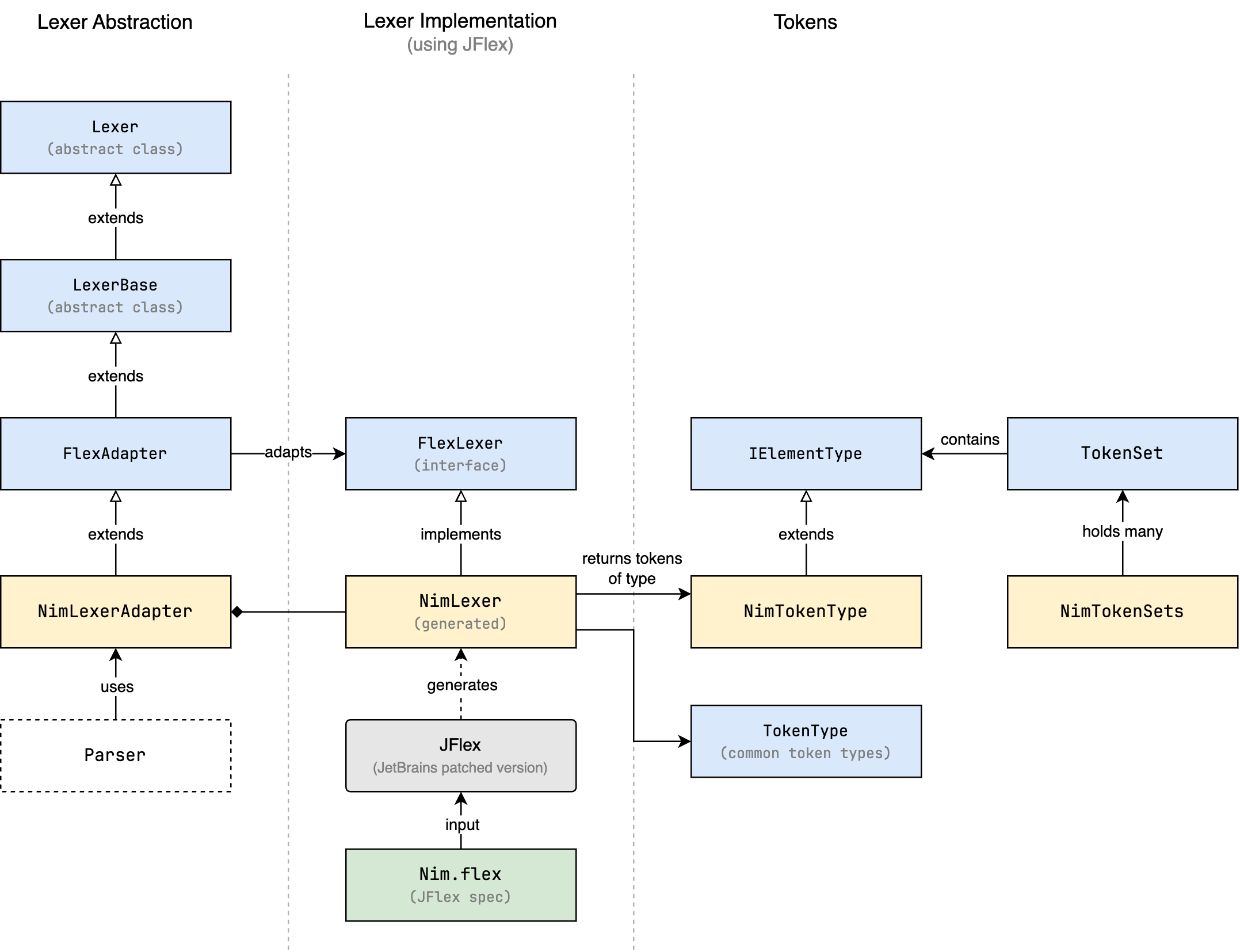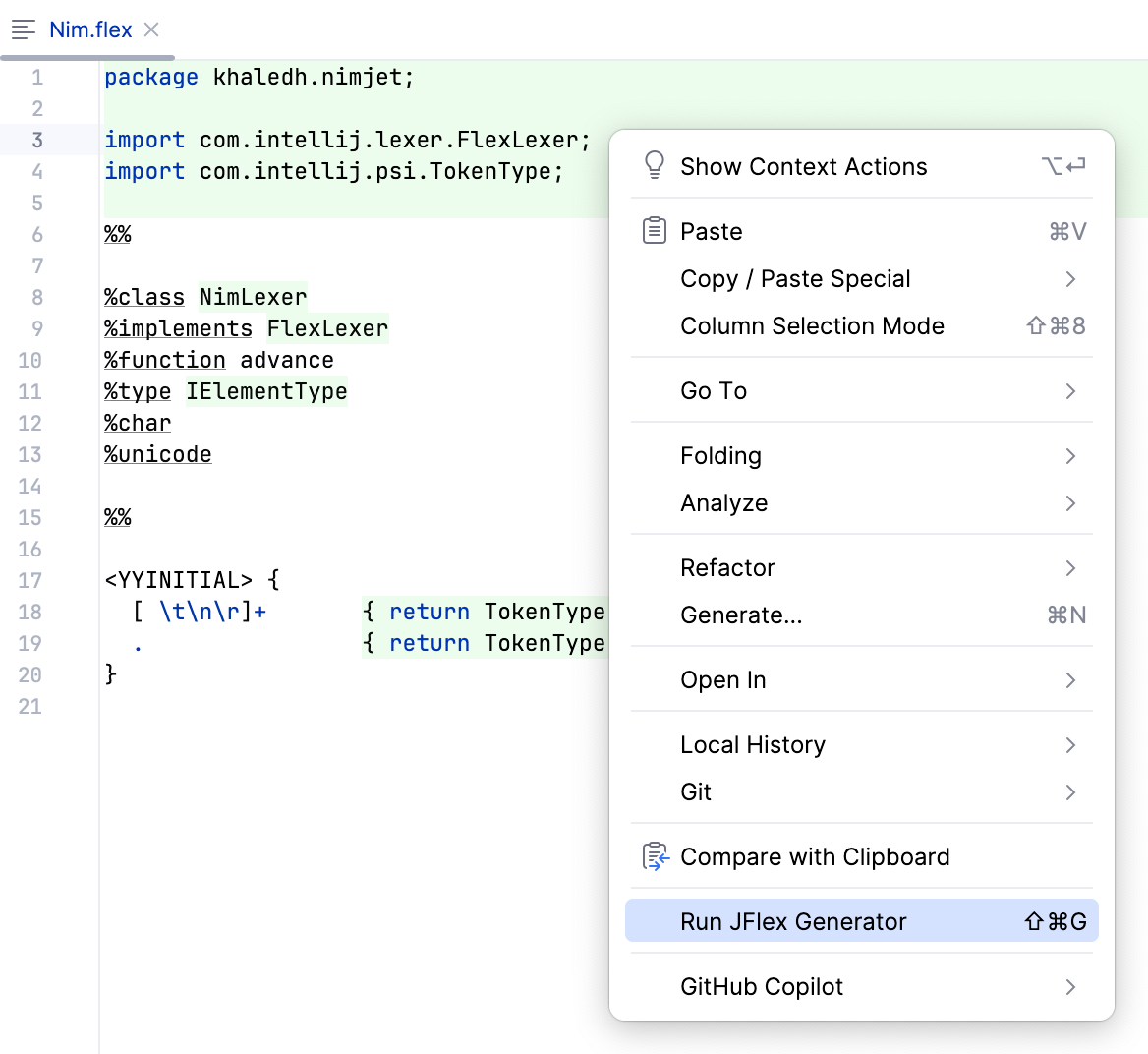Lexer
The role of the lexer is to tokenize the input text into a stream of tokens. Typically, this stream of tokens is used by the parser to build the Abstract Syntax Tree (AST) of the code, or in the case of an IntelliJ language plugin, the PSI tree, which we will get to in a later section. Another use for the lexer is to provide syntax highlighting in the editor, which gives different colors to different tokens depending on their type.
The Lexer Interface
The IntelliJ Platform provides an abstract class called Lexer that language plugins can extend to implement their own lexer.
public abstract class Lexer {
public abstract void start(CharSequence buffer, int startOffset, int endOffset, int initialState);
public abstract int getState();
public abstract IElementType getTokenType();
public abstract int getTokenStart();
public abstract int getTokenEnd();
public abstract void advance();
public abstract LexerPosition getCurrentPosition();
public abstract void restore(LexerPosition position);
public abstract CharSequence getBufferSequence();
public abstract int getBufferEnd();
}
Typically, the lexer works in a pull mode, where the caller repeatedly calls the getTokenType and advance in a loop to get the next token in the stream, until getTokenType returns null to indicate the end of the stream. The getTokenStart and getTokenEnd methods return the start and end offsets of the current token in the input buffer. The other methods are used to manage the lexer's state and position in the input.
We can implement our own lexer from scratch by extending the Lexer class, but this is rarely done in practice. Instead, a lexer generator is typically used to generate the lexer code from a lexer specification. The lexer specification is a set of pattern matching rules that define the tokens in the language. Fortunately, the Grammar-Kit plugin supports the JFlex lexer generator out of the box, so we can use it to generate the lexer for Nim.
Lexer Components
Let's first understand the different classes and interfaces that are involved in the lexer. The following diagram shows the relationships between these classes and interfaces.

- Given a lexer specification file, here called
Nim.flex, JFlex generates a lexer class calledNimLexerthat implements theFlexLexerinterface. - However, the platform expects a lexer class that extends the
Lexerabstract class, so an adapter class is needed to bridge the two. In our case, this adapter class is calledNimLexerAdapter, and it extends theFlexAdapterbase class, which does the actual work of adapting theFlexLexerinterface to theLexerinterface. This is the class that will be used by the parser, not the generatedNimLexer. - The
NimTokenTypeclass is a specialization of theIElementTypeclass, which is used to represent the different types of tokens in the language. The lexer will return instances ofNimTokenType(which we will create later), or one of the built-in token types defined in theTokenTypeclass, according to the matching rules in the lexer specification. - In some cases, we may need to refer to a set of tokens as a single entity. For example, the set of all keywords in the language, or the set of all operators. This is where the
TokenSetclass comes in, which is a holder ofIElementTypeinstances. We will declare all token sets in theNimTokenSetsclass for easy access.
Lexer Specification
JFlex comes from a family of lexer generators that has roots in the lex tool that was developed to generate lexical analyzers under Unix. Given a lexer specification file, JFlex generates a lexer class in Java that can be used to tokenize the input text.
The lexer specification file includes three sections separated by %%:
// User code
%%
// Options and declarations
%%
// Lexical rules
- User code
- This part is copied verbatim to the generated lexer class. It typically contains package declarations, imports, and other user-defined code.
- Options and declarations
- This part contains JFlex options and declarations. Options are used to configure the behavior of the lexer generator, while declarations are used to define variables and methods that are used in the lexical rules.
- Lexical rules
- This part contains the pattern matching rules that define the tokens in the language. Each rule consists of a regular expression pattern followed by a Java action that is executed when the pattern is matched. The action typically returns the token type of the matched token.
Let's start by creating a minimal lexer specification file, Nim.flex, which contains the bare minimum to tokenize only whitespace for now (anything else will be considered a bad character).
// src/main/kotlin/khaledh/nimjet/Nim.flex
package khaledh.nimjet;
import com.intellij.lexer.FlexLexer;
import com.intellij.psi.TokenType;
import com.intellij.psi.tree.IElementType;
%%
%class NimLexer
%implements FlexLexer
%function advance
%type IElementType
%char
%unicode
%%
<YYINITIAL> {
[ \t\n\r]+ { return TokenType.WHITE_SPACE; }
// error fallback
[^] { return TokenType.BAD_CHARACTER; }
}
In the first section, we declare the package and imports that will be copied to the generated lexer class.
In the second section, we specify the options and declarations:
- we specify the name to be used for the generated lexer class:
NimLexer, - specify that it implements the
FlexLexerinterface, - speicfy the name of the function that advances the lexer to the next token as
advance, - specify the return type of the
advancefunction asIElementType, - specify that the lexer should count characters (so that the current offset is available to the parser), and
- specify that the lexer should use the full Unicode input character set.
- we specify the name to be used for the generated lexer class:
In the third section, we define the lexical rules. The rules are defined within the scope of states. The lexer can be in one of several states, depending on the context (e.g. inside a string literal, inside a comment, etc.). The initial state is called
<YYINITIAL>. Here, we define the following rules under the initial state:- The
[ \t\n\r]+regex matches one or more whitespace characters and returns the built-inTokenType.WHITE_SPACEtoken type. - The
[^]is an error fallback regex that matches any character that was not matched by any of the previous rules, and returns the built-inTokenType.BAD_CHARACTERtoken type. We're using this expression instead of.since it matches any character, including newlines and unpaired Unicode surrogate characters.
Later, we will add more rules to match the different tokens in the language.
- The
Generating the Lexer
The Grammar-Kit plugin provides an action to generate the lexer from the lexer specification file. To do that, right-click on the Nim.flex file in the project view or the editor, and select Run JFlex Generator from the context menu.

This will generate the lexer class under the src/main/gen directory that looks like the following:
// Generated by JFlex 1.9.2 http://jflex.de/ (tweaked for IntelliJ platform)
// source: src/main/kotlin/khaledh/nimjet/Nim.flex
package khaledh.nimjet;
import com.intellij.lexer.FlexLexer;
import com.intellij.psi.TokenType;
class NimLexer implements FlexLexer {
// ...
}
In order to include the generated lexer in the project, we need to add the src/main/gen directory to the sourceSets in the build.gradle.kts file:
// build.gradle.kts
...
sourceSets {
main {
java {
srcDirs("src/main/gen")
}
}
}
Let's also mark the src/main/gen directory as a generated source directory in IntelliJ. To do that, right-click on the src/main/gen directory in the project view, and select Mark Directory as | Generated Sources Root.
Automating the Lexer Generation
There's one inconvenience though: every time we change the lexer specification file, we need to manually run the JFlex generator to update the lexer. To automate this process, we can use the generateLexer task that comes with the Grammar-Kit Gradle plugin. Let's add the plugin to the build file and configure the task:
// build.gradle.kts
plugins {
id("org.jetbrains.intellij.platform") version "2.0.1"
id("org.jetbrains.kotlin.jvm") version "2.0.20"
id("org.jetbrains.grammarkit") version "2022.3.2.2"
}
...
tasks {
generateLexer {
sourceFile = file("src/main/kotlin/khaledh/nimjet/Nim.flex")
targetOutputDir = file("src/main/gen/khaledh/nimjet")
purgeOldFiles = true
}
compileJava { dependsOn(generateLexer) }
compileKotlin { dependsOn(generateLexer) }
}
This configures the generateLexer task and makes it a dependency of the compileJava and compileKotlin tasks, so that the lexer is generated every time the project is compiled.
At this point it would be good to test the lexer to make sure it's working as expected. Unfortunately, we can't register the lexer directly. We'll need to create a parser definition and register that first, which provides access to the lexer. We'll get to that in the next section.